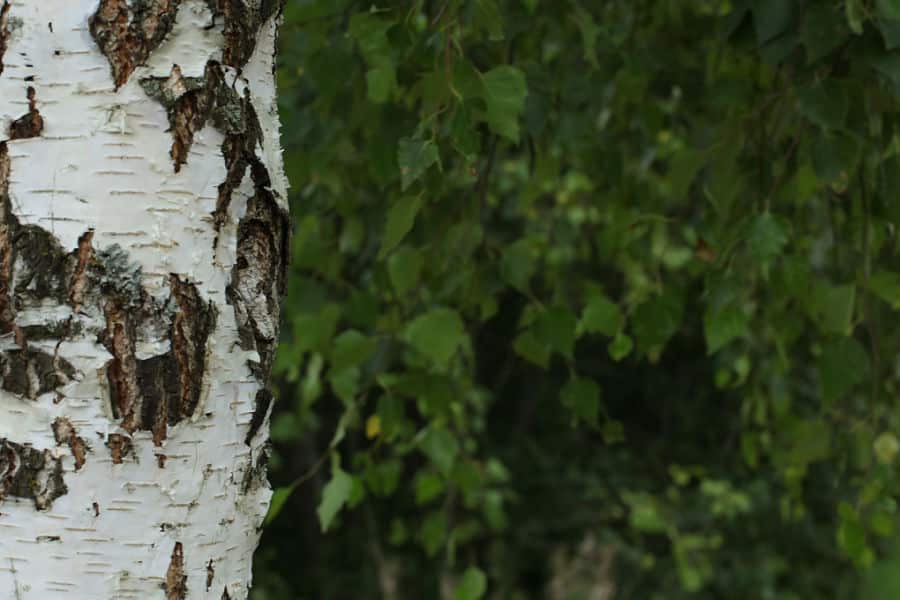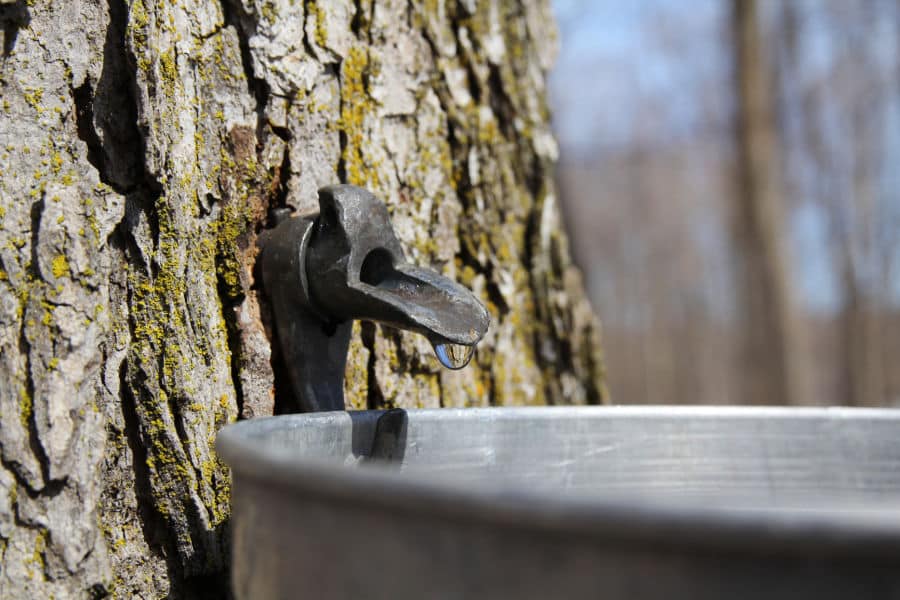
What parts of a tree can you eat?
Most people love to eat things that come from trees. In addition to delectable fruit like apples, cherries, oranges, pears, peaches, and wild nuts like walnuts and chestnuts, there is much more that trees have to offer. A very few of us are aware of the edible yields of trees that come through other tree parts such as bark, leaves, twigs, seeds, roots, pollen, flowers, and sap.
For instance, maple trees not only provide a tasty maple syrup, but their seeds and young leaves are edible too. Also, the famous birch trees can be tapped for the extraction of a sweet juicy sap. In addition to that, the young twigs and inner bark of birch trees are finely edible. That’s not it; several pine trees have similarly valuable edibles to offer. Below we highlight these tasty trees further.
What Can Be Eaten on Deciduous Trees?

Among deciduous trees, the American beech is an exceptionally magnificent specimen to mention. This majestic tree is slow-paced in terms of growth but takes up to a height of 100 feet with an equal spread. Native to eastern North America, it has a sober gray bark and a verdant green foliage that shimmers in hues of golden during Fall. The American beech tree is loaded with small, edible nuts that are tasty enough but less known. Pluck some fresh green leaves off this tree to cook a healthy green dish during Spring. The inner bark of this tree can be used as flour after drying and pulverizing - however, that only qualifies as a survival food and not something you want to include in your everyday diet.
Birch Tree
The Birch tree has unique white bark that makes it stand out. The inner part of this bark is actually edible and has kept many from losing their lives to starvation. Native people often dry and grind the inner bark of birch trees to use it as flour. Similarly, it can be cut into stripes for being boiled as noodles or to be added to soups and stews. During Spring and Summer, you can tap the tree to slurp on the flavorful birch tree syrup or boil it for a sweeter taste.
Linden Tree
The Linden tree, also known as a basswood, is a beautifully-shaped tree with a greyish bark. The tender leaves of this tree can be eaten raw or cooked into a good-veggie meal. Also, the pretty flowers on this tree can be steeped into refreshing tea.
Maple Tree
The Fall show of colors offered by sugar maple tree (A.Saccharum) are stunning – ranging from intense orange to bumble yellow to velvety red.
Interestingly, sugar maples have unique, three-lobed leaves that are slightly notched. In contrast to these, black maples are less notched and have dense black bark. Similarly, the silver maple has five-lobed leaves with deep narrow indentations in between them and a silvery-white underside.
It goes without saying that sugar maples are famous for the delectably sweet maple syrup that comes from its sap. But did you know that many other varieties of the larger maple trees also produce sap? These varieties include the black maple (the sap of which tastes almost the same as that of the sugar maple) and the silver maple (also having an equally tasty sap). The saps that you extract from varieties other than the sugar maple are always going to vary in taste and flavor. However, that must not keep you from experimenting and exploring!
Besides the sap, the inner bark of maple trees can be eaten raw as a survival food. The young leaves and seeds are also edible. People from ancient times hulled at larger maple tree seeds and boiled them before they ate them.
Mulberry Tree
The Mulberry (M.Rubra and M.Alba) are moderately-sized fruit-bearing trees. Emanating from their round crown over a short trunk, the tender twigs of mulberry trees are sweet and edible. People would often pluck them off to eat them raw or after slight boiling.
Walnut Tree
The famous Juglans species can be tapped for the extraction of a sweet flavored sap. While this holds true for all Juglans specimens, the butternut and black walnut species are particularly well known for sap production.
Oak Tree
The sturdy resolute oak trees produce acorns, which are very less known for being edible. While all acorns are good to be consumed, some of them are sweeter than others. For instance, the white oak acorns are sweet, the bur oak acorns have a chestnut flavor, whereas the red oak acorns are more bitter.
Poplar Tree
The Populus Genus is rich in poplars and aspens, both. It has a sweet and starchy inner bark that can be consumed once cooked or even raw. Also, you can slice it into thin strips to grind it into a carbohydrate-rich flour.
Sassafras Tree
The Sassafras tea is very well known for its pleasant aroma. Many people would chew on the young and tender, green-barked twigs of a Sassafras tree for its delicious flavor. Not only the twigs, the young leaves and green buds of this tree are also delectable. Add them to your salads or use them (after removing their veins and drying) to thicken your soups and stews. In short, every part of the Sassafras tree is a treat to feast on!
Slippery Elm
While the name sounds a little magical, a slippery elm is well-known for its wide usage as a herbal medicine. The dense and fragrant inner bark of an elm is very sticky but is a great source of nourishment.
Willow Tree
Willows are strong and hardy trees, and also a great food source when needed. The inner bark of willows can be eaten raw, cooked into spaghetti when cut in strips, or can be ground into flour. The young willow leaves are a little too bitter but can come in handy as a survival food in emergency times.
What Can Be Eaten on Evergreen Trees?

The entire pine family makes a vital source of food for most of the wildlife out there. The inner bark and sap of pine trees are loaded with Vitamin A and C along with many other vital nutrients. It can be sliced into strips for being boiled into spaghetti or can be ground into flour for being used as a soup thickener or for being baked into bread. During Spring, do not hesitate to tap a pine tree to extract some sap and drink it up as tea.
The young pine needles on a pine tree are also super-rich in vitamins and nutrients. Although they wouldn’t be consumed as a whole, people would often chew on them for about 5 minutes to swallow their juices. Alternatively, you can steep these needles into tea – pine and fir needles make an excellent tea for the Winter season.
In addition to these, a pine tree has cones, seeds, and pollens to offer, all of which are edible. The female woody cones produce seeds that are delicious to be consumed when shelled or roasted. However, the nutritious pine nuts are not considered consumable as they are tiny and hard to get to – you would need a hammer or a rock to break through the shell. Some other pine nuts can be larger than sunflower seeds and are delectably consumable. For example, the seeds on the Italian Stone Pine, Pinyon Pine, Korean Pine etc.
The soft male cones of pine trees are also edible but are preferred for cooking due to their strong taste. During Spring, these cones produce pollen – too much pollen that you can actually scoop it from the golden heaps of pollen on the ground.
Other Cupressaceae family genera such as cedars, Thuja, and Arborvitaes also have edible, nutritious inner bark. Native people would dry the bark from these trees off and grind them into a fine powder for emergency uses during traveling.
Saps, Syrups, and Tapping

There are numerous trees that can be tapped for their syrup and sap. However, not all of these will offer a sweet juicy sap like that of a sugar or silver maple tree. Most of this sap would be bland, bitter, or bad in taste and quality. For example, the sap that comes from tapping a hickory tree has a very unpleasant taste. Whereas tapping a black nut or butternut tree would bring you a fine-tasting rich syrup.
Similarly, the sap of a sycamore tree is way too dark and strong in terms of flavor to be consumed. Identifying the right trees for sap extraction can be a highly complex process, but it’s always good to learn the basics.
- Choose a tree that is at least 18-20 inches in diameter. This may sound huge but you will end up collecting only a quart or two of finished syrup per tap.
Tip: Get yourself some spiles and pails for sap collection beforehand!
- Make a V-shaped cut in the tree. At the base of this cut, drill a 2 inch deep cut and close it with a peg. Whenever you are ready to collect sap, take off the peg and insert a spile that should help transport the sap from the tree to the container or bucket being used for collection.
- A spile is an essential sap collecting tool. It can be made up of various materials, including bamboo, metal, or even a sturdy twig or branch piece. The lid of a tin can also be turned into a spile once you have smoothened its edges.
- Once you have collected the sap, it's only a matter of boiling it with water to separate the waste that rises to the top. The ideal ratio of water to sap is 35:1. Don’t worry - the water will evaporate soon, leaving a clear tangerine syrup. Don’t forget to strain it carefully!
- Continue boiling until a spoonful of syrup turns into a soft ball when dropped into cold water. Stop boiling there and beat it using an egg beater, then pour it into a container.
